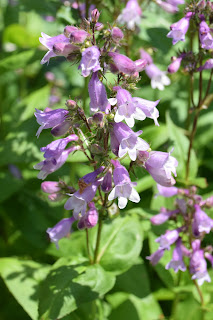 |
Eurybia divaricata
|
Known as botanical Latin or scientific Latin, it is the
tongue-twisting nomenclature rooted (literally) in a language which technically
does not exist. According to Wikipedia, it is a language based on
New Latin and used
specifically for description of organisms. For those looking to identify a
plant in a serious way, it is essential—it is how you know what you really have
(unlike
common
names which can be shared by multiple plants and which can have meanings
that are not always obvious, such a plant called ‘pineland-ginseng’ which is
not related to the other plant with the common name ginseng at all).
I interchangeably refer to the official name of a plant as
either the scientific name or the Latin name. It is the name given by
taxonomists to plants (as well as all organisms, you may know humans as Homo sapiens). Sometimes the name given
never changes; sometimes the names are replaced with new (determined to be more
accurate) names but they always keep the old name as a synonym. For example,
the New World plants known as Aster are now reclassified into several new
genera (‘genera’ is the plural of genus—they were actually split into more than
one new genus). What was Aster
divaricatus is now Eurybia divaricata.
A surprising number of nurseries still call it that.
Botanical Latin is composed of two parts: the genus name
which is a noun and is always capitalized (Quercus
for oak); and the species epithet which
is an adjective, is not capitalized, and often provides some descriptive
information (such as alba, indicating
white: Quercus alba). Then the whole
thing is italicized. Occasionally, the species name may be hyphenated but remains
a single adjective: Athyrium filix-femina
for lady fern. Varieties and subspecies may add extra terms beyond the species
epithet: Chrysogonum virginianum var. brevistolon for the short-stolon
variety of green & gold; or Sambucus
nigra ssp. canadensis for
American elderberry.
 |
Chrysogonum virginianum var. brevistolon is my favorite!
|
Let’s talk a minute about the species epithet. It is
selected for a number of reasons: it might describe color (alba/white, rubra/red),
origin or habitat (georgianum/of
Georgia, occidentalis/western), form
or habit (maculata/spotted, hirta/hairy, altissima/tall, arborea/tree-like).
Occasionally, plants are named to honor someone and the name doesn’t offer any
descriptive clue at all (michauxii,
porteri, loriae).
The spelling of the species name can vary quite a bit and I
believe that might be rooted more in an attempt to match Latin characteristics
(male/female). As a fun exercise, I found every spelling of the epithet “of
Virginia” that I could (Georgia doesn’t have as many but here’s
a blog I did about it):
Claytonia virginica Chionanthus virginicus
Diospyros virginiana
Veratrum virginicum
Botrychium virginianum
Cirsium virginense
Saxifraga virginiensis
 |
Penstemon smallii, named for Mr. Small
|
Here is another aspect to spelling to consider. Often the
ending of the species name will match the ending of the genus name: Helianthus
angustifolius, but sometimes it
doesn’t: Prunus angustifolia. It's a pain to have to look it up everytime when memorization fails you.
If I’m struggling to remember
the spelling (the aforementioned Chickasaw plum makes me pause almost every time),
I use a little trick that I created: I remember another species in the same
genus—in this case I think of black cherry,
Prunus
serotina—and then apply the same
ending (the ‘a’ in this case). So far that hasn't failed me but I'm sure there's an exception out there somewhere to trip me up.
I hope this was interesting and maybe even helpful. Here are
a couple of resources that I found helpful. Now go out there and memorize the
Latin name of your favorite plant.
https://awaytogarden.com/decoding-botanical-latin/
https://www.gardeningknowhow.com/garden-how-to/info/latin-plant-names.htm







































